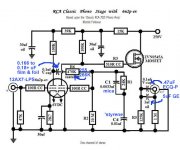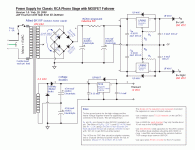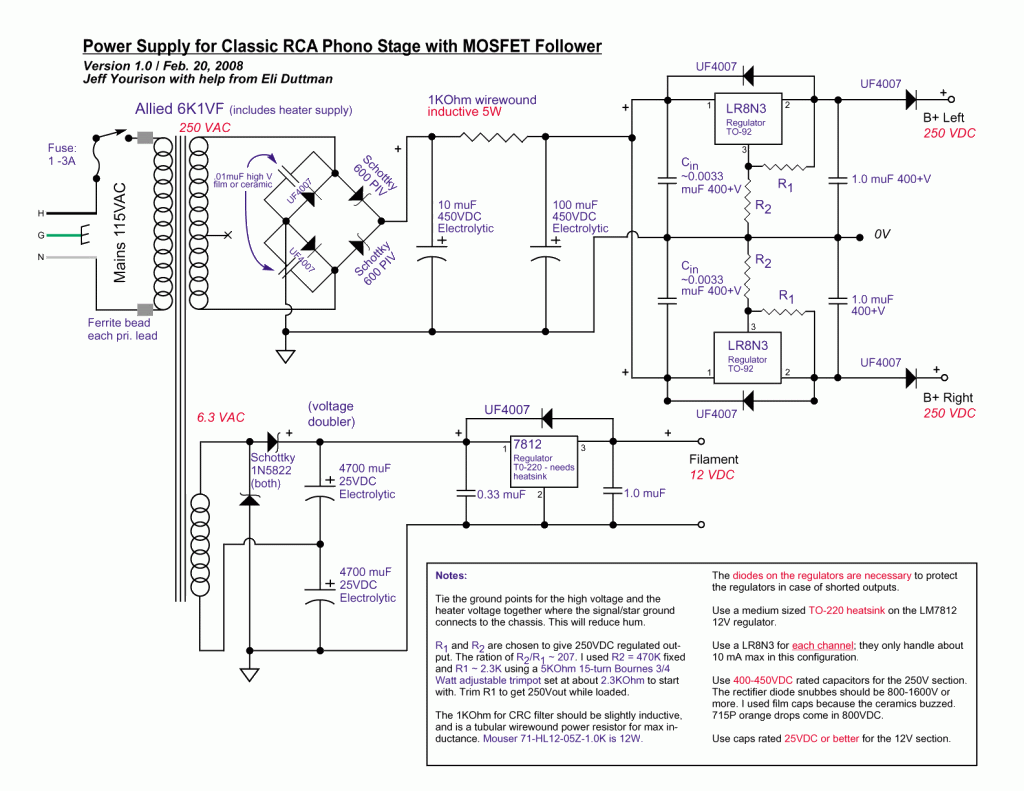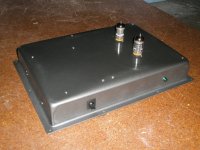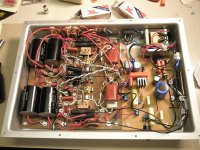I'm looking to build a tube phono preamplifier (first time) for a recently completed Tubelab SE 300B, and would like some recommendations for kits or schematics.
I'm currently using a Rega Planar 3 turntable with an Ortofon OM5E cartridge rated at 4mV output.
The input sensitivity of the 300B amp measures at 0.707V, so if I'm correct, the phono preamp would need to put out about 0.7 to 1V. With a 4mV cartridge, the phono preamp inputting directly to the 300B amp would need to provide a gain of about 38db, according to the KAB calculator. Does that seem right?
Years ago I heard a George Wright WPP100C driving a pair of SET monoblocks (a one-off precursor to the Mono 7; it was a 300B designed to sound more like a 2A3), and was utterly blown away by the detail, musicality, and 3D depth/breadth of the soundstage. I realize recapturing that in a first time build is highly unlikely, but I've got to start somewhere.
So far, the following projects seem applicable. Does anyone have opinions as to the sound qualities and suitability to my power amp? Any other projects I should consider?
* Glassware Tetra Sans PS (I'd use the Janus or PS-1 power supplies)
* Glassware PH-1 (would probably use the PS-1 power supply)
* Bottlehead Seduction or Reduction (new or used)
* I have Kevin Kennedy's (aka KTA and kevinkr here) Little Book of Preamplifier Projects, and the 1-tube and 2-tube per channel designs look eminently feasible and affordable.
Thanks!
I'm currently using a Rega Planar 3 turntable with an Ortofon OM5E cartridge rated at 4mV output.
The input sensitivity of the 300B amp measures at 0.707V, so if I'm correct, the phono preamp would need to put out about 0.7 to 1V. With a 4mV cartridge, the phono preamp inputting directly to the 300B amp would need to provide a gain of about 38db, according to the KAB calculator. Does that seem right?
Years ago I heard a George Wright WPP100C driving a pair of SET monoblocks (a one-off precursor to the Mono 7; it was a 300B designed to sound more like a 2A3), and was utterly blown away by the detail, musicality, and 3D depth/breadth of the soundstage. I realize recapturing that in a first time build is highly unlikely, but I've got to start somewhere.
So far, the following projects seem applicable. Does anyone have opinions as to the sound qualities and suitability to my power amp? Any other projects I should consider?
* Glassware Tetra Sans PS (I'd use the Janus or PS-1 power supplies)
* Glassware PH-1 (would probably use the PS-1 power supply)
* Bottlehead Seduction or Reduction (new or used)
* I have Kevin Kennedy's (aka KTA and kevinkr here) Little Book of Preamplifier Projects, and the 1-tube and 2-tube per channel designs look eminently feasible and affordable.
Thanks!
Here is the tweaked RCA Classic phonostage that Eli, Buzz and others have worked on. The power supply will follow if you're interested. (I thought Merlin had just posted it, but it's gone at the moment.)The range in values shown is intended to keep a key RC product constant.
Attachments
Is there a thread or write for the posted schematic?
Scan the archives here and over on AA. More than 1 thread will turn up.
The original thread was spread over several forums, one of which was lost to hacking. 
There are a few builders out there. Here is my original quick prototype build. It could be done more compactly in a nicer enclosure; this is mostly point to point, and is set up to allow changing out the capacitors for experimenting. (The enclosure is a Fat Daddy-o 9" x 13", 2" deep cake pan, inverted.)
I like the new Mullard reissues, the Sovtek LPSs, and some older RCA mil-spec tubes in it.
The power supply is on the right, and the actual preamp channels are on the left. The heat sink is for the 12V heater regulator; it gets only mildly warm. I used a mix of 'styrene and mica in the equalization section, and the output caps are GE surplus with Panasonic film and foil bypass. The large black decoupling caps are Solen.
There are a few builders out there. Here is my original quick prototype build. It could be done more compactly in a nicer enclosure; this is mostly point to point, and is set up to allow changing out the capacitors for experimenting. (The enclosure is a Fat Daddy-o 9" x 13", 2" deep cake pan, inverted.)
I like the new Mullard reissues, the Sovtek LPSs, and some older RCA mil-spec tubes in it.
The power supply is on the right, and the actual preamp channels are on the left. The heat sink is for the 12V heater regulator; it gets only mildly warm. I used a mix of 'styrene and mica in the equalization section, and the output caps are GE surplus with Panasonic film and foil bypass. The large black decoupling caps are Solen.
Attachments
Thanks for the information. I have a copy of an RCA tube manual from 1959 that seems to have that same circuit (#19-15, on p. 364), though of course without the MOSFET follower.
I take it you like the performance of the RCA phono pre? Any idea what the frequency response, total gain, and RIAA accuracy are?
I take it you like the performance of the RCA phono pre? Any idea what the frequency response, total gain, and RIAA accuracy are?
The tweaks to the RCA original correct 2 weaknesses: very poor drive capability and mediocre bass extension. The FET buffer disposes of the drive issue and grid leak biasing the 2nd gain block lightly loads the EQ network, for better deep bass behavior.
If you run the numbers provided by RCA, you will find gain of about 45 dB., which seems to be pretty darned good. You want the phono preamp to produce roughly the same signal strength as a "standard" CDP (2 VRMS).
If you run the numbers provided by RCA, you will find gain of about 45 dB., which seems to be pretty darned good. You want the phono preamp to produce roughly the same signal strength as a "standard" CDP (2 VRMS).
I am unsure of precise gain, but I don't have to make any volume matching adjustments when switching the source from CD to phono. My guess is that it's close to typical CD level output with my MM Shure M97xe cartridge. The follower reduces output impedance, allowing it to work with 10K input impedances (most amps?).
People say the RIAA accuracy is pretty good -- the schematic was tweaked some (before I did non-critical tweaks) by a couple of people who got it pretty close to the curve.
It sounds neutral to me. Tube rolling doesn't affect it all that much except perhaps to fatten mid-base or, in the case of RCA tubes, seemingly extend the highs a little. The biggest differences are in each record; some are simply better engineered and recorded, I guess. The best recordings really sound good. It might have more bass emphasis than my CD player—I notice that, when comparing the same recordings in CD and vinyl format, but it could just be the remastering on the CD. I don't have the equipment to really analyze this.
[Edit: Eli beat me to this, and did a better job explaining.]
People say the RIAA accuracy is pretty good -- the schematic was tweaked some (before I did non-critical tweaks) by a couple of people who got it pretty close to the curve.
It sounds neutral to me. Tube rolling doesn't affect it all that much except perhaps to fatten mid-base or, in the case of RCA tubes, seemingly extend the highs a little. The biggest differences are in each record; some are simply better engineered and recorded, I guess. The best recordings really sound good. It might have more bass emphasis than my CD player—I notice that, when comparing the same recordings in CD and vinyl format, but it could just be the remastering on the CD. I don't have the equipment to really analyze this.
[Edit: Eli beat me to this, and did a better job explaining.]
Last edited:
The Shure M97xe has the same output voltage (4mV) as the Ortofon currently in my TT. The input sensitivity on my amp is 0.707 VRMS, and we did measure the input impedence but I have those numbers away from me at home, but the RCA definitely sounds like a viable candidate.
I kind of wanted to avoid MOSFETs, if only because there's a MOSFET follower in my 300B amp and it doesn't have that traditional, sweet sound normally ascribed to tube amps.
But I've got some learning to do before I take on this project, and this information helps a lot.
Any other suggestions out there?
I kind of wanted to avoid MOSFETs, if only because there's a MOSFET follower in my 300B amp and it doesn't have that traditional, sweet sound normally ascribed to tube amps.
But I've got some learning to do before I take on this project, and this information helps a lot.
Any other suggestions out there?
Ooh, that is interesting. Two stage 6N23P with a 6N23P SRPP output (?) at 24V B+.
If we're headed across the phono frontier to the motherland, this one has always intrigued me:
Jeremy Epstein's 6C45P Phono Preamp page
I kind of wanted to avoid MOSFETs, if only because there's a MOSFET follower in my 300B amp and it doesn't have that traditional, sweet sound normally ascribed to tube amps.
The odds are long that the source follower is not causing your voicing complaint. I am not a 300B fan, as I think it generates excessive 2nd order HD. Perhaps your amp was set up to eliminate euphony in favor of honesty. "Different strokes for different folks." As I favor honesty, I might easily like your amp driving my 94 dB. sensitive bass reflex speakers.
Ooh, that is interesting. Two stage 6N23P with a 6N23P SRPP output (?) at 24V B+.
If we're headed across the phono frontier to the motherland, this one has always intrigued me:
Jeremy Epstein's 6C45P Phono Preamp page
The 6C45П (6s45p) comes perilously close to oscillating in its cardboard box.
Yeah, but I don't have any 6S45P's kicking around in my tube box 
This isn't my thread, but I'll take the opportunity to ask you a question, oh wise one Eli. Why don't we see more three stage phono preamps? It seems like the RIAA EQ could be split and shared among three triodes instead of squashed between two. Or we could use a third stage as a low gain, low output impedance stage. Like a 6DJ8>RIAA>6DJ8>12B4A kind of arrangement.
It's probably been done, but I haven't seen it much. I suppose fewer stages is preferred insofar as the KISS approach, but the 40db+ gain requirement (more if you want 2V RMS output) really limits tube choices.
This isn't my thread, but I'll take the opportunity to ask you a question, oh wise one Eli. Why don't we see more three stage phono preamps? It seems like the RIAA EQ could be split and shared among three triodes instead of squashed between two. Or we could use a third stage as a low gain, low output impedance stage. Like a 6DJ8>RIAA>6DJ8>12B4A kind of arrangement.
It's probably been done, but I haven't seen it much. I suppose fewer stages is preferred insofar as the KISS approach, but the 40db+ gain requirement (more if you want 2V RMS output) really limits tube choices.
Many of the good phono stages here are over in analog source where you'll find the Salas phono stage, several by Koi Farm, and at least 4 by yours truly. I am a bit puzzled by the fact that most members never ever recommend designs by fellow members. There are some good ones here. (the examples here are all tube or tube/hybrid)
http://www.diyaudio.com/forums/analogue-source/140635-valve-itch-phono.html
http://www.diyaudio.com/forums/diya...oise-thoroughly-modern-tube-phono-preamp.html
http://www.diyaudio.com/forums/analogue-source/213769-muscovite-6s3p-tube-phonostage.html
http://www.diyaudio.com/forums/analogue-source/273817-muscovite-mini-iii-6n23p-phono-stage.html
http://www.diyaudio.com/forums/analogue-source/242855-mini-me-phono-preamp.html
http://www.diyaudio.com/forums/analogue-source/255041-mini-me-second-edition-tube-phono-preamp.html
http://www.diyaudio.com/forums/analogue-source/140635-valve-itch-phono.html
http://www.diyaudio.com/forums/diya...oise-thoroughly-modern-tube-phono-preamp.html
http://www.diyaudio.com/forums/analogue-source/213769-muscovite-6s3p-tube-phonostage.html
http://www.diyaudio.com/forums/analogue-source/273817-muscovite-mini-iii-6n23p-phono-stage.html
http://www.diyaudio.com/forums/analogue-source/242855-mini-me-phono-preamp.html
http://www.diyaudio.com/forums/analogue-source/255041-mini-me-second-edition-tube-phono-preamp.html
Many of the good phono stages here are over in analog source where you'll find the Salas phono stage, several by Koi Farm, and at least 4 by yours truly. I am a bit puzzled by the fact that most members never ever recommend designs by fellow members.
Part of the issue is that although the forum is great for active collaboration and communication, it isn't ideal for research when someone can't follow all the technical back and forth, especially when we are talking about something as subjective as audio performance. People want a definitive "Build X for Y Dollars Budget." Of course, that doesn't exist. Probably the real solution to your puzzlement is that the designers aren't quick enough to toot their own horns. Maybe out of reluctance to seem narcissistic or fear of technical nitpickery. If your design is good, by all means beat us over the head with it and go to war with detractors.
Good links though. I don't know about that Muscovite dealio with the batteries and (ACK) solid state devices though
Last edited:
- Status
- This old topic is closed. If you want to reopen this topic, contact a moderator using the "Report Post" button.
- Home
- Amplifiers
- Tubes / Valves
- Tube Phono Preamps
